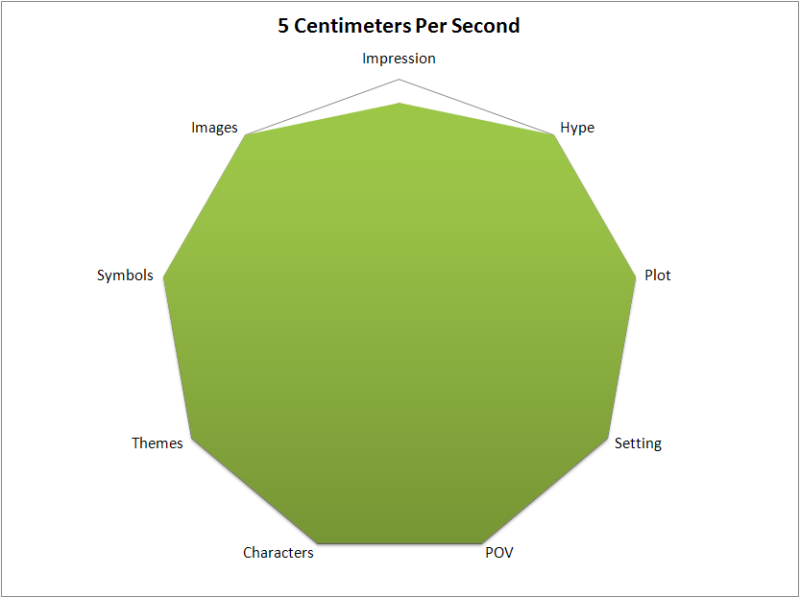Introduction
True to its name, this movie doesn’t move along much faster than 5 centimeters per second, but it’s not a bad thing – there’s a good reason for the pace of the series. Like his earlier works, Makoto Shinkai has created a heart-touching story between two star-crossed lovers that hits home so hard that even King Arthur couldn’t seize the sword that will surely pierce your heart; every frame of the movie is filled with incredible amounts of detail (scenery porn), every scene carries some sort of meaning or theme, and the ending is esoteric.
5 Centimeters per Second is one of the greatest works of all time, even when compared against great Hollywood films, such as Casablanca and Gone with the Wind; the series absolutely outdoes every single anime movie and anime series that I’ve seen thus far – and probably ever.
Characters
As usual, I will just list out the characters and give a quick blurb about them.
- Takaki Tōno: The main protagonist of the story. The movie follows Takaki’s emotional downfall, and his subsequent recovery at the very end. Albeit, the second episode focuses on another girl who’s in love with Takaki, but for the most part it can be argued that Takaki is the main protagonist. He’s a kind, soft-spoken male who continues to wait for his first love, Akari. Although, I’m not entirely sure why he’s so hung up on Akari, because if he truly wanted to be with her, wouldn’t he try to pursue her once he got out of college? He was so deeply heartbroken that he couldn’t bare to work anymore. Hell, if you truly love someone that much, you might as well stalk them out on Facebook and profess your undying love for them. But I don’t want to downplay or satire the work of the author by using this character as a vehicle for that, because I know what it’s like to be there. I know what it’s like to be in love and not have the person you love be with you – it’s worse when you know that person moved on without you. That’s the perpetual state that Takaki is in – a constant “I’m left behind” state that cripples his life for 14 years. Several opportunities pass him by and he even gives up the possibility to be happy with one of two girls who had fallen hopelessly in love with him just for the prospect of being with Akari. Poor guy…
- Akari Shinohara: Akari is Takaki’s love interest, who just so happens to love him back. Unfortunately, she has to move far away from Takaki and the two begin to drift apart. Not much screen time is used on Akari, but we do know that she’s a considerate, reasonable girl who is just trying to get through life. We learn in the third episode that she’s in an arranged marriage and is depressed over the fact, but she hides it very well from her parents and the audience for that matter. She occasionally thinks about Takaki, but is mostly focused on making her arranged marriage work, by showing affection for her husband. Naturally, we see that she doesn’t have the same issues as Takaki – a superpower women tend to hoard from the male race.
Plot | [Full Spoilers]
5 Centimeters per Second follows the relationship between the main character, Takaki Tōno, and his far-away love, Akari Shinohara. The movie is broken up into three different segments – episodes – and each one shows Takaki at a different stage in his life. This first episode focuses on Takaki when he’s between the age of 10 and 13 – the movie doesn’t specifically tell the audience – and he meets a girl named Akari. The second episode jumps 5 years into the future when Takaki is a senior in high school. The third episode concludes the story 9 years afterwards, ending the movie when Takaki is approximately 27 years old.
Episode 1: Cherry Blossom
This film starts off soft and innocent with our winsome protagonist, Takaki Tōno, discussing the speed at which Cherry Blossom peddles drift to the ground with his friend, Akari Shinohara. The episode is split between two different time-lines that interleave:
- A view of what’s happening in the audience’s perception of the present
- And a time-line consisting of flashbacks that paint past events; mostly consisting of how Takaki and Akari met and grew closer to one another
In the present, Takaki and Akari have already been separated because of Akari’s parent’s careers. But the two lovebirds still keep in touch with one another via snail-mail; this was in the early 1990’s, before cellphones and free long-distance VOIP. The distance between the two isn’t great enough to stop them from communicating with one another. Alas, Takaki learns that he will have to move away within a short amount of time; farther away from Akari. The two plan to meet one last time before breaking the event horizon of fate. Takaki plans to meet Akari at the train station closest to her home.
Takaki’s train route to Akari’s town is extremely long, twisted, and requires a lot of transfers between the trunklines. Albeit, our romantic hero carefully prepares a timetable based upon the train schedule to follow in order to arrive at a reasonable time.
On the day of the their meeting, Takaki prepares a letter for Akari confessing his true feelings for her and sets out on his, what will soon become a torturous, journey. While on the train, we flashback to how Takai and Akari meet.
Both of our cute little love doves meet in elementary school. Takaki and Akari suffer from seasonal allergies and spend their recess inside. Naturally, they begin talking to one another and grow closer together; “they speak to each other using their given names without any form of honorifics, which is very unusual in Japan, even among people who are romantically involved. This fact is lost in the movie’s translation to English and other languages, which reduces the implied closeness of their relationship.”
After graduating from elementary school Akari moves away, much to Takaki’s dismay. Despite the strong bond between the two, they begin drifting further and further apart. Soon, Takaki learns that his family will be moving far away – too far for Akari and Takaki to even have a remote chance of visiting one another. In their last grasp for one another, the two plan to meet up with before the move
Back in the present, a freak snowstorm has blindsided Takaki’s plans to meet up with Akari. The trains are slowing down. Delays are stacking up. Connections are lost. Takaki frequently turns his left wristwatch. And in a dear moment, Takaki drops his letter to Akari and suddenly loses heart – a little bit. But love perseveres! Notwithstanding, Takaki slowly pushes through the weather’s relentless onslaught. What a soldier. After two long hours of setbacks, our hero finally meets up with his princess.
A defeated Takaki slowly walks into the station and finds Akari patiently waiting for him. With her head down and hands folded, she slowly raises her head and breathes in a sigh of disbelief. Takaki slowly approaches Akari and she grabs his hand and begins to cry tears of happiness. Takaki, equally as taken, embraces her. The two of them share a small dinner together before being shuffled out of the room into the blizzard. The couple find a lonely shack to stay for the night and share their first kiss. A moment later, Takaki realizes that the two are destined to be Star Crossed Lovers.
The next morning, Akari waves Takaki off at the train-station. As the train departs, Takaki gazes out the window and regrets losing the letter he meant to give to Akari; Akari looks into her bag and sees the letter she was supposed to give to Takaki…
Episode 2: Cosmonaut
Fast-forward 5 years to when Takaki is in his senior year of high school. We’re introduced to another girl, Kanae Sumida, who’s been in love with Takaki since he joined their middle school (See here for the Japanese education system). Kanae is a amateur surfer and completely unsure of her future. She has no idea where or what she wants to do; all she wants is Takaki to love her.
The episode shows Kanae’s attempts to tell Takaki that she loves him, but failing to do so due to her own insecurities. Takaki and Kanae constantly spend time together, but Takaki only sees Kanae as just a friend and doesn’t seem to notice that Kanae has feelings for him. He also seems to be staring off into the distance and constantly emailing someone from his cell phone. After a several years of unrequited love, Kanae finally concludes that Takaki is probably thinking of something else or someone else; someone that can give him something more than she could.
At the end of the episode, we see Takaki sending emails to himself…
Episode 3: 5 Centimeters per Second
9 years later, Takaki is at an undisclosed software company coding sql scripts (has absolutely no relevance; I just recognized the code he was typing). He drags his feet to home and work everyday, feeling nothing but gloom. He says,
“Through the act of living itself, sadness piles up here and there”
Takaki smokes, drinks sodas, doesn’t even attempt to clean his room – he’s given up all hope on Akari and himself. He’s so heartbroken that he can barely hang on. Under the immense emotional stress of his long-gone love, he quits his job.
We see that he has an ex-girlfriend that is still in love with him. She texts him and calls him constantly – worrying for Takaki’s well-being. After all these years, Takaki still can’t let go of Akari.
On a sunny, breezy afternoon Takaki is walking along a familiar path through the blowing cherry blossoms and walks over a set of train tracks. The crossing gates are flashing and lowering their arms. And Takaki passes a familiar women, dressed in white and pink. Takaki thinks to himself,
“I had a strong feeling that if I turned my head, she would too…”
The two stop just outside of the crossing guards and begin to slowly turn around. In a mirror image of the past, right before the two see one another, a train flies between them – and the women disappears. Takaki’s eyes soften, and he gently smiles to himself. And just like everyone else, he turns back to the way he was headed…and moves on.
Themes
The reason this anime is so incredible is because the director emphasizes many themes – as with his previous works. I feel that talking about them in essay format would be difficult and a bit too forceful. Instead, I’ll go ahead and list out a few themes that were emphasized in this series:
- “I Will Wait For You” Theme (Subverted): When Akari and Takaki depart one another, the two begin to drift farther away from one another. Even though the two said they would wait for one another no matter what, it’s obvious to those jaded by the same promise that unrealistic love-goals are impossible. Although Takaki does stay true to his word, it wasn’t because he wanted to; it’s because he couldn’t. He was too emotionally attached to Akari and he was physically unable to break away from her. At the end of the movie, you can see part of Akari’s letter to Takaki ended with the line, “But I’m sure you’ll be fine,” which indicates that perhaps she was prepared to make their visit their last encounter. Yet, she never had the heart to give it to him. It’s possible that even though she knew she had to let go, she just couldn’t bring herself to break Takaki’s heart.
- Moving On, Moving Along: The movie is named 5 Centimeters per Second for several reasons, two of which are
- That’s the speed at which cherry blossom peddles drift to the ground
- Despite what you might be going through, moving along is important
Now, those things might sound a little unrelated, but listen to what I have to say. Cherry blossom peddles start out close to one another. They grow out of the same flower bulb. They are brother and sister. They are together. But as time goes on, those cherry blossoms break off and begin to drift farther and farther away from one another. And soon, they are forever taken by the gusts of fall – never to see one another again. This movie is about the very same thing happening between people. Takaki and Akari were extremely close to one another when they were children. But as time went on, they began to drift farther apart – destined to be separated for eternity.
The other thing I wanted to say is that everything moves slow. Time, life, love. They all move slowly. But they do move. Life continues to happen. People continue on. We all continue walking – marching on. The howls of our past might roar in our ears, but it can’t stop us from taking another step forward. Whether it takes seconds, minutes, years, or decades, everyone needs to continue moving forward. And like our hero, we’ll all find an answer to whatever has been keeping us locked in the past, even if it takes 14 years to do so. Just my little inspirational speech that I don’t get to put into my reviews. hehe. (^_-).
- Start Close, End Far: As I’ve said above, the movie is named 5 Centimeters per Second because it’s about falling down, really slowly. It’s about moving along really slowly. Have you ever had a childhood friend you knew many years ago, but, for whatever reason, couldn’t keep up with? Have you ever fallen in love with someone, broken up with them, and then look back years later and wonder about them? How you could be so close and now so far? That’s what this movie is about
Final Thoughts | Conclusion
5 Centimeters per Second was one of the most beautiful – both visually, emotionally, and intellectually – anime movies I’ve ever had the pleasure of watching. I came across this series when I saw a background for it on deviantart. I then forwarded the anime series to Josh, who, surprisingly, had never heard of it either. So we both checked out the ratings for the series and were delightfully surprised to see it get perfect scores across the board among several different websites. I immediately downloaded it and watched it – and used up a box of tissues in the end. After that, I recommended it to my friend Josh and Bryan who shared an equal amount of praise and tears for the series. One thing seems to be agreeable about this series: it’s a masterpiece. It ranks among the highest in my collection of anime. It’s one of the most meaningful and inspirational anime I’ve seen. The visuals, the art, and the characters tug at your heartstrings and send you back into your own memories of when you first fell in love. Even if you haven’t, you’ll still find yourself crying at the reality of truth in the movie.
Score | Charts
Rating: 9.98 = ~99.8%
Rating Chart

Attribute Chart




